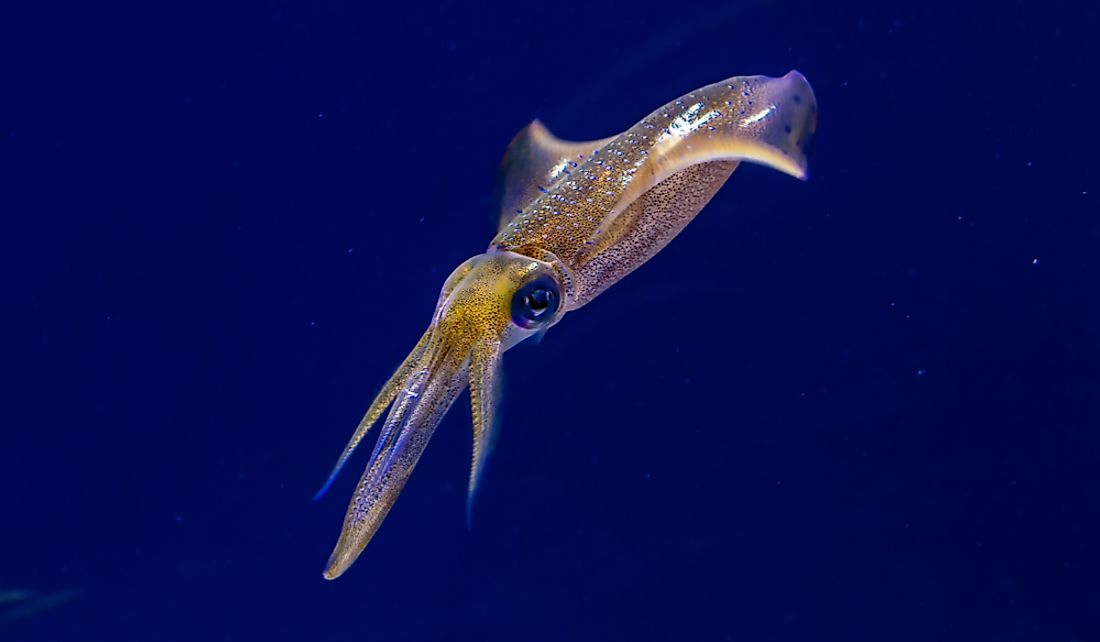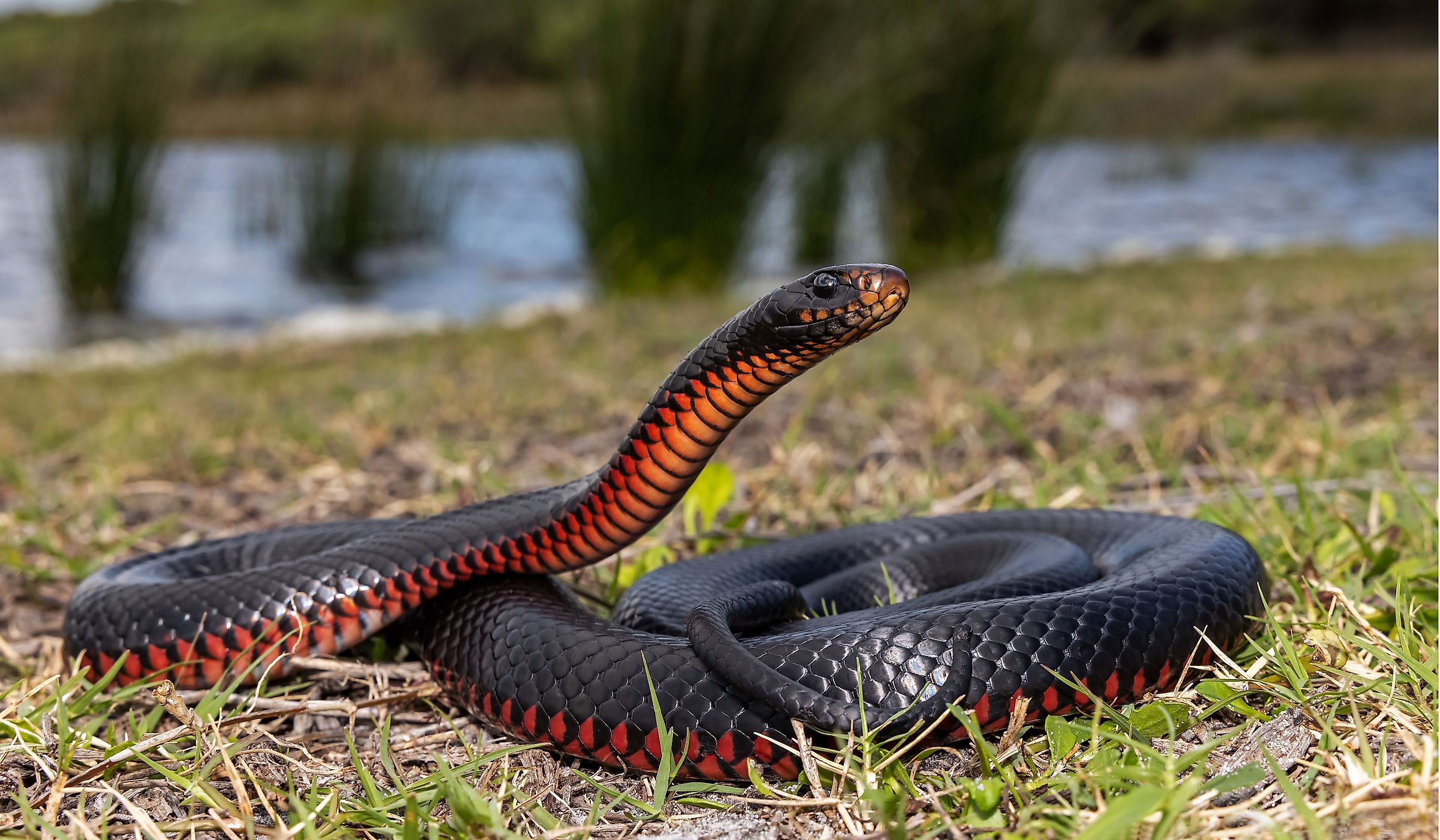
The Most Snake Infested Lakes in Nebraska
Often celebrated for its sweeping prairies and expansive skies, Nebraska offers a mix of outdoor adventure, immense wildlife, and recreation. But it comes with no shortage of hazards. While enjoying Nebraska’s many lakes and reservoirs, keep an eye out for their scaley inhabitants. While the notion of snake-infested waters might send shivers down your spine, these snakes offer an unparalleled glimpse into Nebraska's diverse ecosystems. Lake McConaughy, Lewis and Clark Lake, Pawnee Lake, and others are more than just vibrant destinations; they are delicate ecosystems teeming with life where snakes play a crucial role. Whether you’re a snake enthusiast or a cautious outdoor adventurer, check out some of the most snake-populated lakes in Nebraska.
Lake McConaughy
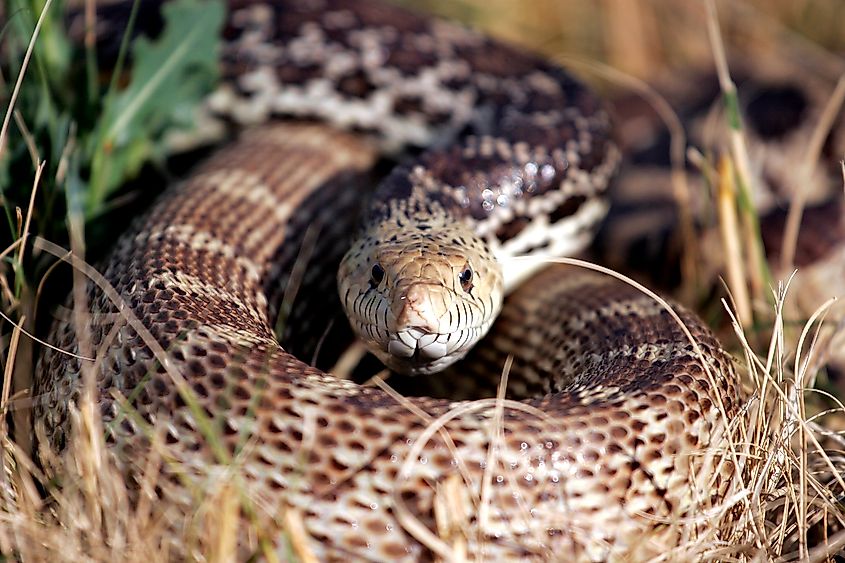
Lake McConaughy, the largest reservoir in Nebraska, is nestled in the western region. It offers a unique mix of natural beauty, recreation, and stunning wildlife. Nicknamed Big Mac, this lake is the perfect getaway for those seeking adventure and a chance to reconnect with nature.
Stretching over 30 thousand acres, this vast body of water is fed by the North Platte River. It is a paradise for water sports such as boating, kayaking, jet-skiing, and windsurfing. Try fishing, camping, or hiking, or enjoy a picnic while watching the wildlife. Take in sandy beaches, rolling hills, and lush grasslands while on the lookout for the Plains Garter Snake, Bullsnake, and the Northern Water Snake.
A common sight around Lake McConaughy, the plains garter snake is easily recognizable by distinctive stripes running down the length of their bodies. These non-venomous snakes play a crucial role in controlling the pest population by eating insects and rodents. Generally shy, these snakes will avoid human contact.
The bullsnake is one of the largest snakes in the area, growing up to 8 feet long. Due to their similar appearance, these snakes are often confused with rattlesnakes. However, bullsnakes are non-venomous and harmless to humans. Known for defensive behavior such as hissing and tail vibrating, they rarely bite but if provoked will defend themselves.
Excellent swimmers, the northern water snake can be found in the water or on land. They have thick, heavy bodies, growing between 24 and 50 inches in length. Though they are non-venomous, these snakes may bite if provoked.
While enjoying Lake McConaughy, be on the lookout for these snakes. Be aware of your surroundings, and do not attempt to handle these snakes. Wear sturdy boots when hiking to avoid accidental bites. Embrace the outdoors while respecting wildlife.
Branched Oak Lake
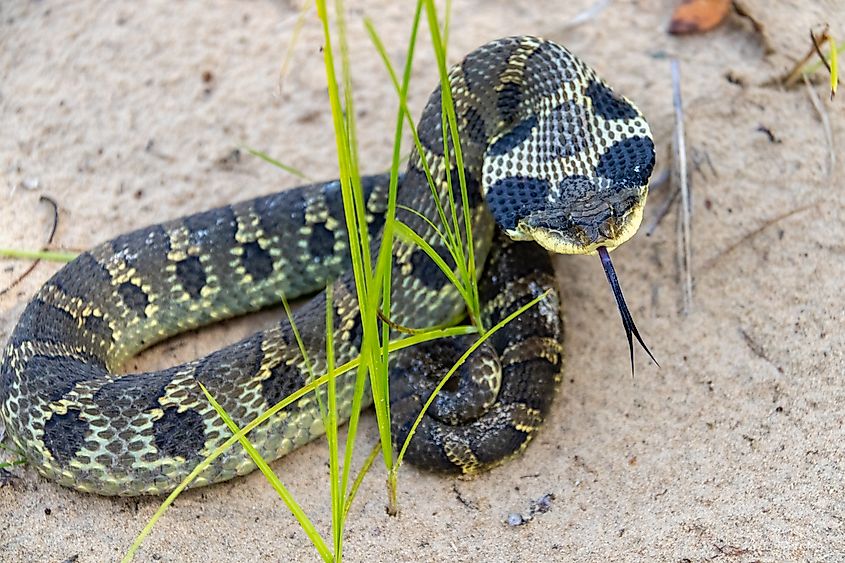
20 miles northwest of Lincoln, Nebraska, Branched Oak Lake is a picturesque oasis drawing nature lovers and outdoor enthusiasts alike. This lake is part of the Branched Oak State Recreation Area, encompassing over 5 thousand acres of water. It is framed by rolling hills, woodlands, and grassy meadows.
With warm summers and colder winters, there are plenty of things to do. From boating, fishing, and camping, to picnicking, hiking and wildlife watching. While enjoying the outdoors, keep your eyes peeled for snakes such as the Western Ribbon snake and Eastern Hognose snake.
The Western Ribbon snake is slender, with a distinctive yellow or cream striped pattern running along its body. Semi-aquatic snakes can be found in the water or on land and feed on small fish, amphibians, and insects. Being non-venomous, these snakes pose no threat to humans.
Known for its upturned snout, the hognose snake ranges from yellow to brown with dark blotches. These snakes are known for their dramatic defensive behavior, flattening their necks, hissing, or playing dead when they feel threatened. They have a mild venom to subdue their prey, typically amphibians. However, they are not dangerous to humans and rarely bite.
Bright green and slender, the smooth green snake is an insectivore. Feeding mostly on insects and spiders, these snakes rely on their green skin to camouflage them while hunting. The green snake is shy and will avoid human contact. In addition to this, they are non-venomous which makes them harmless to humans.
While enjoying your time outdoors on Branched Oak Lake, you may be lucky enough to spot a snake. Observe from a distance and avoid provoking them. Enjoy the scenic beauty and coexist with these fascinating creatures.
Harlan County Lake
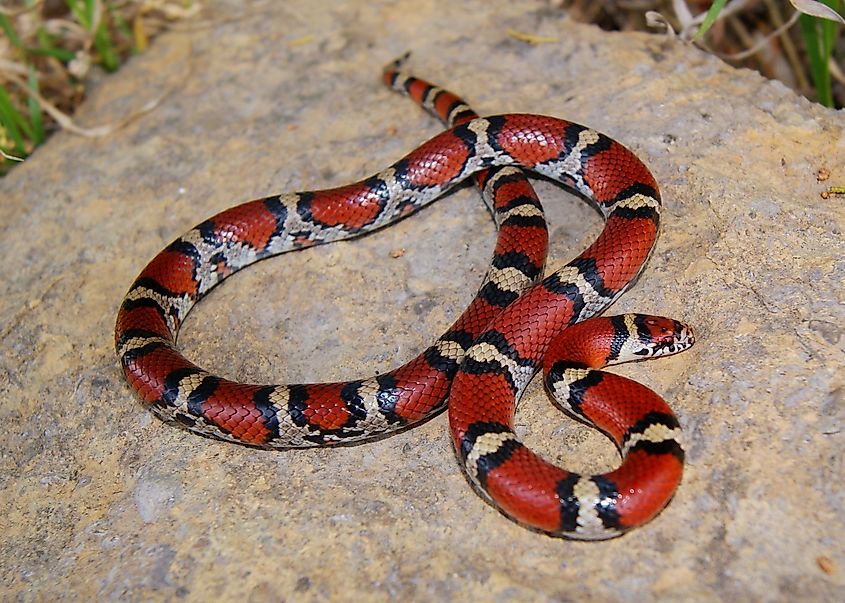
The second-largest reservoir in Nebraska, Harlan County Lake is a picturesque haven nestled in the south-central part of the state near the Kansas border. It stretches over 13 thousand acres with 75 miles of shoreline. Fed by the Republican River, this lake supports a wide range of flora and fauna, sustaining a diverse ecosystem.
Try out boating and fishing or relax at one of the lake’s numerous campsites. A popular destination for hunting, during the appropriate seasons you can hunt for deer, turkey, pheasants, and waterfowl. The lake's diverse habitats support snakes such as the common garter snake, great plains rat snake, and milk snake.
The Great Plains rat snake is grey or light brown with distinct dark blotches. Medium-sized, these snakes have a V-shaped making on their heads. They are skilled climbers, so you may find them on land or in a tree. Being non-aggressive and non-venomous, these snakes rely on their camouflage to avoid threats and pose no harm to humans.
Milk snakes are colorful with bands of red, black, white, or yellow, sometimes mistaken for the coral snake. However, these snakes are not venomous, which distinguishes them from coral snakes. These snakes are non-aggressive and feed on rodents, birds, and small animals. Milk snakes are known for their ability to mimic more dangerous snakes as a defense mechanism but pose no threat to humans.
Another snake you’ll find here is the eastern yellow-bellied racer. Olive green to grey, these fast-moving, slender snakes have smooth scales with a yellow or white underside. Being active hunters, these snakes are known for their speed and agility, feeding on rodents, insects, and amphibians. Though they are non-venomous, these snakes may show aggressive behavior and bite if cornered or handled.
If you encounter a snake while enjoying Harlan County Lake, stay calm and back away slowly. Do not provoke the animal. Be aware of your surroundings and wear protective clothes to avoid accidental encounters. Respect Harlan County Lake’s wildlife, and you’re sure to have a great time.
Lewis and Clark Lake
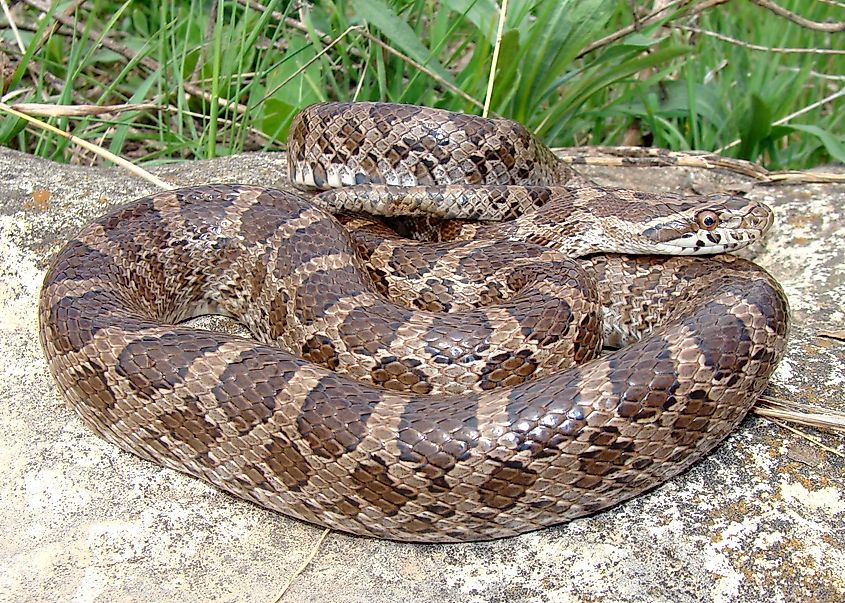
Situated on the border with South Dakota, this lake offers stunning landscapes and rich history. It spans over 31 thousand acres and is surrounded by dense woodlands and hills. Enjoy watersports, camping, hiking, or historical exploration. Visitors can explore part of the Lewis and Clark Expedition and visit the Visitor Center to dive into the historical significance of their expedition. The natural habitats around Lewis and Clark Lake support a wide variety of plant and animal life, making it a haven for snakes.
You can find the previously mentioned great plains rat snake, eastern yellow-bellied racer, and milk snake around this lake. You may also find the prairie kingsnake, a brown or grey snake with blotches along its body. Growing up to four feet long, these constrictors prey on rodents, birds, and other snakes. They are secretive and generally avoid human contact. Being non-venomous, they pose no threat to humans.
While journeying through history, if you encounter a snake, give it plenty of space and view it from afar. Stay on marked trails and wear protective clothing. Embrace the chance to connect with nature and wildlife while remaining safe.
Calamus Reservoir
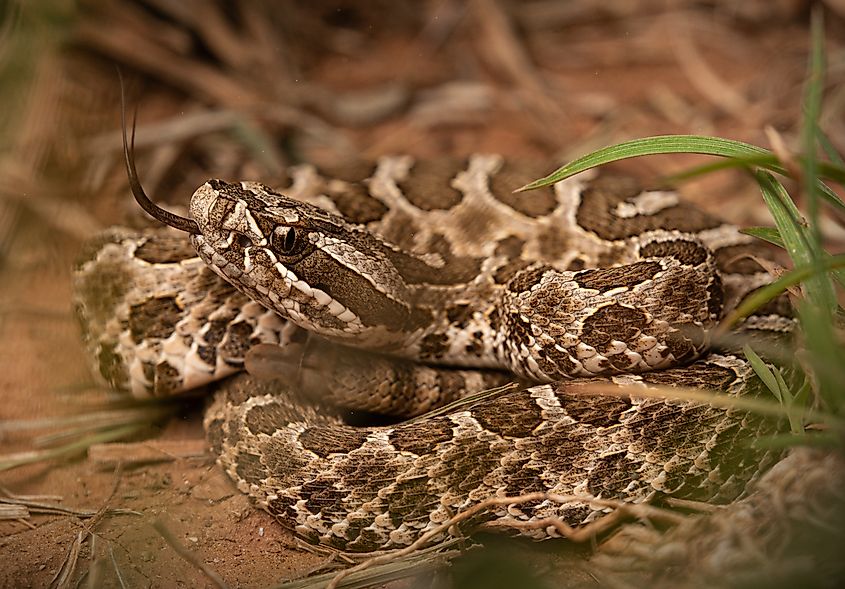
Located in the Sandhills region, this reservoir is known for its blue waters and diverse wildlife, spanning roughly 5 thousand acres. Characterized by sandy dunes, prairies, and woodlands, you can enjoy boating, fishing, hiking, camping, and bird watching. Relax along the shoreline and have a picnic, spotting wildlife like deer, turkey, or snakes.
Ring-necked snakes may be found hiding under rocks, logs, or leaf litter. They are small, slender snakes with orange or yellow rings around their neck. Feeding on small amphibians, insects, and earthworms, these non-venomous snakes pose no threat to humans.
Another snake you may come across at Calamus Reservoir is the western Massasauga. This small rattlesnake has a stout gray or brown body with dark blotches. Being ambush predators, these snakes wait in hiding to ambush their prey, feeding on small mammals, amphibians, and reptiles.
These rattlesnakes are venomous and may bite if provoked or threatened. If you hear the rattling of their tail, this is a warning sign the animal is about to strike. If you encounter the western Massasauga, back away slowly and stay calm. Do not agitate the snake.
While exploring the water, keep an eye out for these scaley creatures. Observe from a distance and do not provoke them. Stick to established paths to minimize accidental encounters. Enjoy your time outdoors while staying safe.
Swanson Reservoir
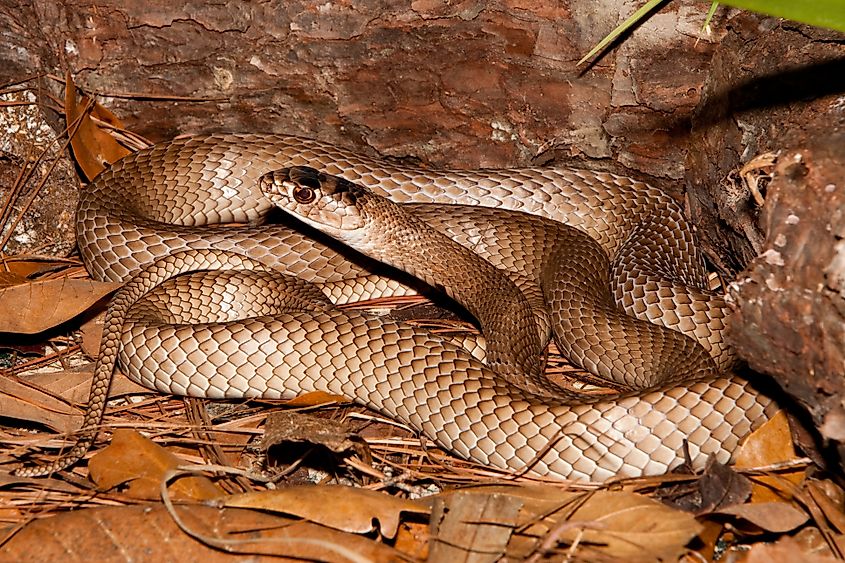
Nestled in the southwestern area of Nebraska, Swanson Reservoir spans over 4,000 acres. With prairies and hillsides, this reservoir is abundant with wildlife and plant species. Created by damming the Republican River, this reservoir is a vital water resource for the region. Offering watersports, hiking, fishing, and camping, there is no shortage of recreation at Swanson Reservoir.
The diverse ecosystem is excellent for wildlife spotting and birdwatching. Discover all sorts of flora around the lake, and be on the lookout for snakes, an integral part of the ecosystem. You may encounter the coachwhip snake, red-bellied snake, or common kingsnake.
Slender and long, coachwhip snake’s coloration range from dark to light with their tail resembling a braided whip. They are active and fast moving, feeding on lizards, rodents, and other snakes. Being non-venomous, they are not dangerous to humans. However, if threatened, they can deliver a painful bite.
Red-bellied snakes are brown or grey with reddish or orange undersides. Found in moist environments, these snakes feed on slugs, earthworms, snails, and insects. Small and secretive, red-bellied snakes are non-venomous and pose no threat to humans.
The common kingsnake is large and shiny with white or yellow bands or spots. They reach up to six feet long and can be found not only in lakes but in urban areas as well. Though daunting, kingsnakes are not aggressive and non-venomous. However, this snake may bite if they feel threatened or surprised.
Encountering a snake can be thrilling and scary. Be mindful of your surroundings, and do not disturb any wildlife you encounter. Continue educating yourself, and enjoy your time at Swanson Reservoir.
Pawnee Lake
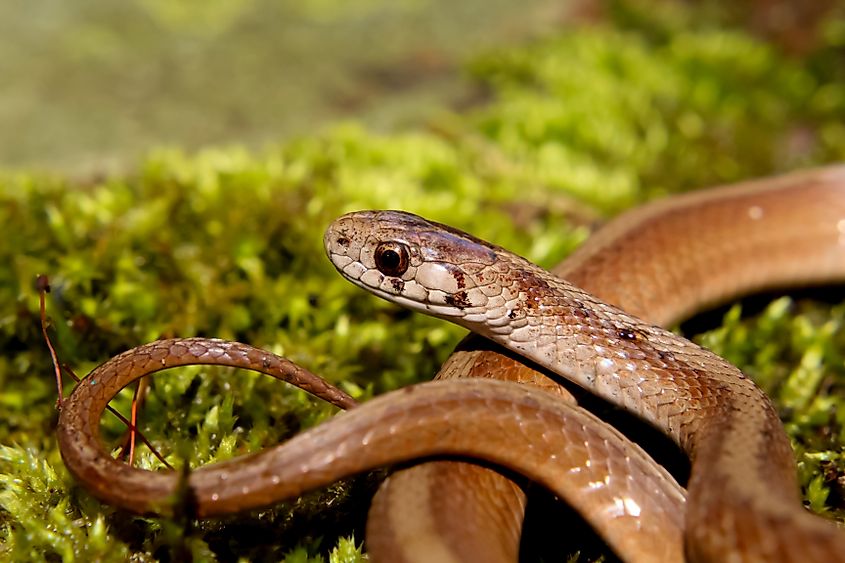
Just a short drive from Lincoln, Nebraska, Pawnee lake offers a serene retreat with its diverse environment and rich history. Created by damming Middle Creek, this lake was designed as part of a flood project. Over 740 acres, this lake is home to a variety of wildlife.
If boating, fishing, hiking, and camping aren’t enough for you, try your hand at wildlife photography, capturing deer, foxes, or birds through a lens. Relax on the shoreline or try a thrilling water sport such as sailing, water skiing, or jet skiing. While taking in Pawnee Lake’s beauty, be on the lookout for snakes such as the lined snake, DeKay’s brown snake, and the gopher snake.
Small with brown or gray bodies, lined snakes feature three yellowish stripes along their backs along with a checkerboard pattern on their undersides. These snakes are nocturnal and often found under rocks or logs, feeding on earthworms and insects. Being non-venomous, lined snakes pose little threat to humans.
DeKay’s brown snakes are small and have light brown or grey bodies. A lighter stripe runs down the center of their back, bordered by small black spots. Found near lakes, gardens, leaf litter, and under debris, they feed on slugs, earthworms, and insects. These snakes are non-venomous and are not dangerous to humans.
The gopher snake is large and robust, with yellow or tan bodies covered in dark brown or black blotches. Due to their size and pattern, these snakes are sometimes confused with rattlesnakes. As ground-dwelling snakes, they feed mostly on small mammals, birds, and eggs. They are non-venomous but are known for their defensive behavior. A warning sign to look out for is hissing and tail vibrating.
Exploring snake-populated areas can be both unnerving and exhilarating. From the tranquil waters of Swanson Reservoir to the rich biodiversity of Lake McConaughy to the rich history of Lewis and Clark Lake, each body of water offers a blend of recreation and diverse ecology. While relishing your time outdoors, take the necessary precautions, such as wearing sturdy boots for hiking and staying on marked trails. Respect snakes and their environment, and if you encounter one, appreciate it from afar.





